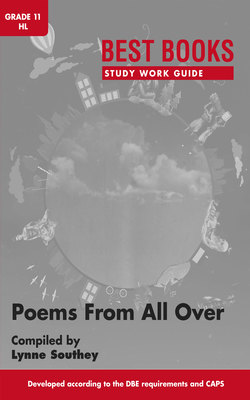Читать книгу Best Books Study Work Guide: Poems From All Over Gr 11 HL - Lynne Southey - Страница 5
Introduction to English poetry
ОглавлениеThis section assumes that you have read the introduction in your poetry anthology. Two sections are referred to here and discussed in more detail.
Interpreting and finding meaning in a poem means being actively involved in it
This is the what of a poem: what does it say or mean? You may not understand the poem on a first reading, but there will be words, phrases, and ideas that you do understand. These give you something to think about. They create expectations that you may have to change on a closer reading. This means you have to be actively involved in creating the meaning. Thinking about why you think or feel what you do means you look for confirmation or for a different idea. Certain thought processes take place.
A second reading may give you a more complete idea of what the poem is about:
•Does the poem have a central image or idea?
•What is the poem about? What is the link between the title and the central image or idea?
•Who is the persona/speaker in the poem?
•Is the persona describing something or someone? Why? How? For what purpose, e.g. to praise, make fun of, criticise or protest against something or someone? It may describe a scene: e.g. nature or the destruction of something. It may be personal, describing an emotion.
•Is the persona telling a story or an anecdote? If so, is it a sad story, a funny story, about a dramatic or tragic event? Is it about a famous historical or heroic character or is it describing an ordinary person in a very personal story? Is the story about a single person or about a group of people? Ask yourself what the poet’s purpose was in writing the poem. Was he or she trying to capture a feeling, a scene, an event?
•What is the atmosphere of the poem? How is this linked to the central image or idea of the poem? How does this make you feel?
•What is the connection between the poem and real life? There may be none for you today, but what about when the poem was written?
•What effect does the poem have on you now that you have thought about it? Do you understand something better? How does it relate to your own life? Does the poem have any very personal meaning for you? To what extent do you agree with its theme? Why?
Thinking through these questions will mean that you are actively involved in reading the poem. They may not all be applicable to the poem you are dealing with, of course. You can see with these questions why bringing your own experience to the poem means that your answers may be different from those of others.
Discussing the poem and the poet’s technique
A poet is an artist using words and language to create a literary text. A poet uses his or her talents, and applies various poetic techniques, to create a particular poem. You need to be familiar with the poetic techniques and look at how the poet uses them and why. Poetic techniques include all the figures of speech (see p. 245 of your anthology), and the poet’s choice of words and imagery (how the poet creates mind pictures, using words).
Asking the following questions may help you when you are considering and discussing the poetic techniques:
•A word or phrase: What is its literal meaning? (A glossary is provided on pp. 245 and 246 in your anthology) Does it also have another, perhaps figurative, meaning? What do you associate with the word/phrase?
•Which words or phrases express or describe feelings? What feelings? How are they described?
•How is the word order arranged? What effect does this achieve?
•An image or metaphor: What does it look like in real life? What does it sound, feel or taste like? Of what does it remind you? With what do you associate it?
•The punctuation: Where does a thought/statement begin and end? How do you know?
•The flow of thought/description: Is it interlinked and/or contrasted and/or developed and/or expressed?
These questions help you to see how the poet has created a poem.
